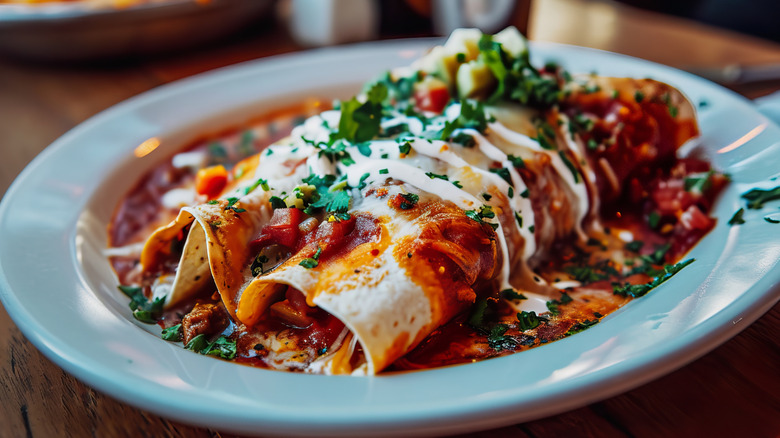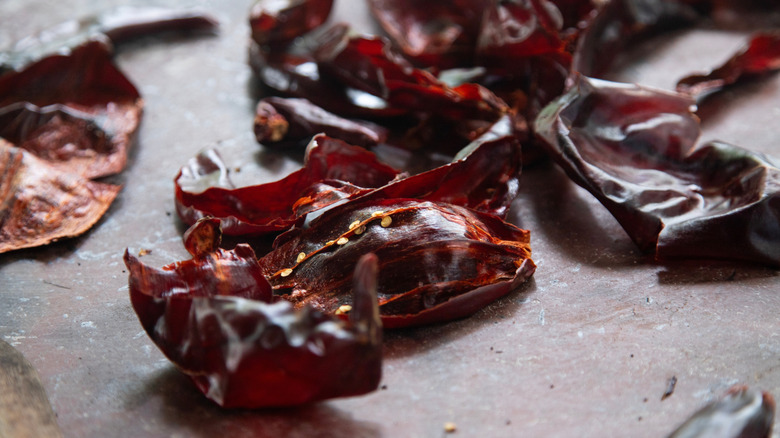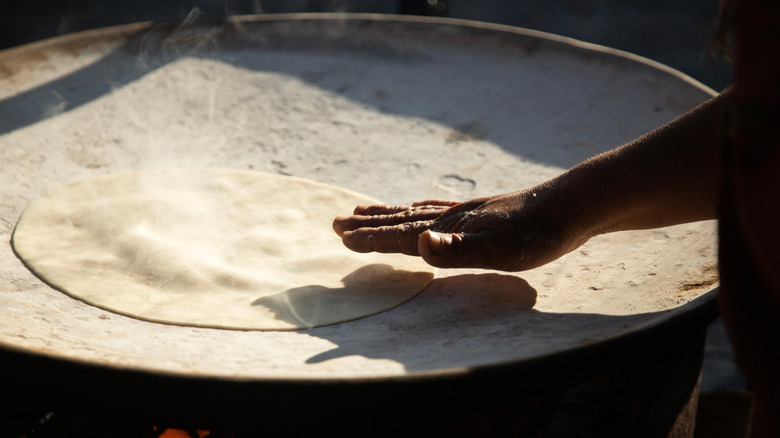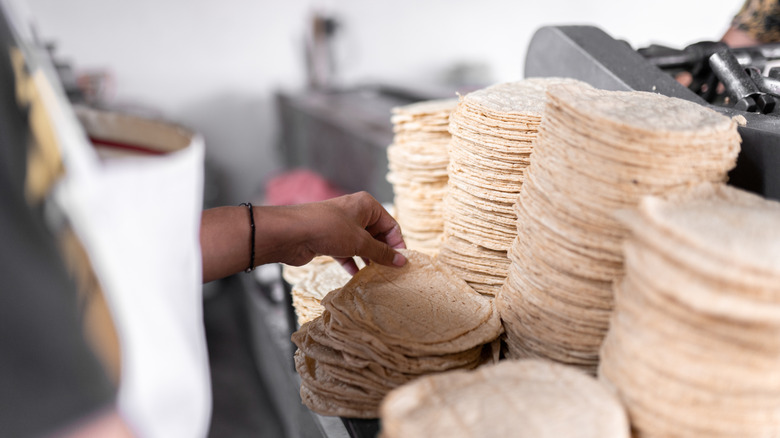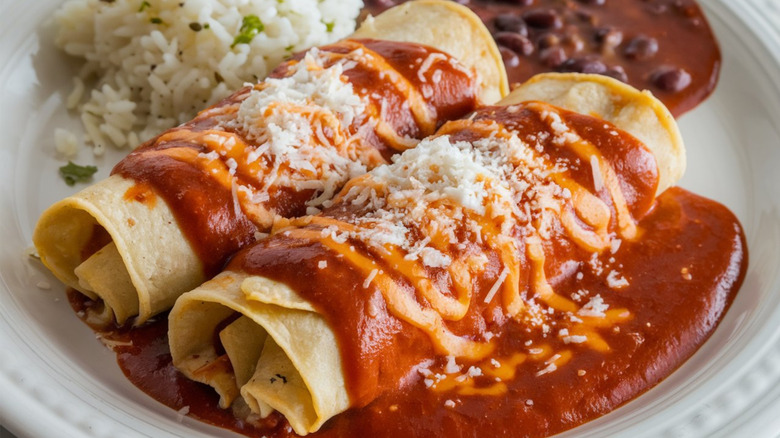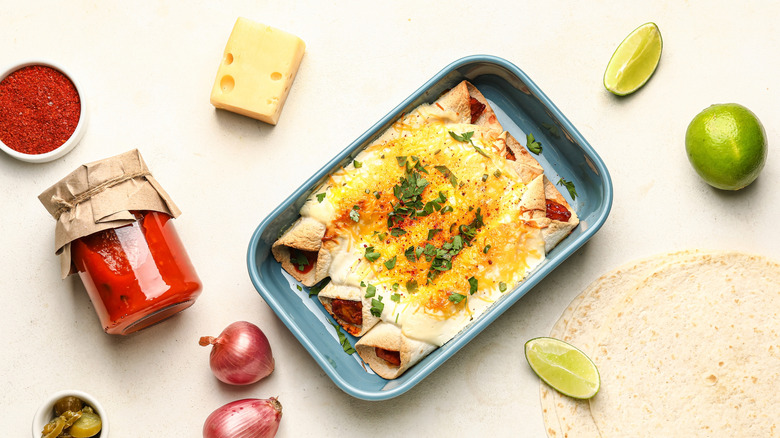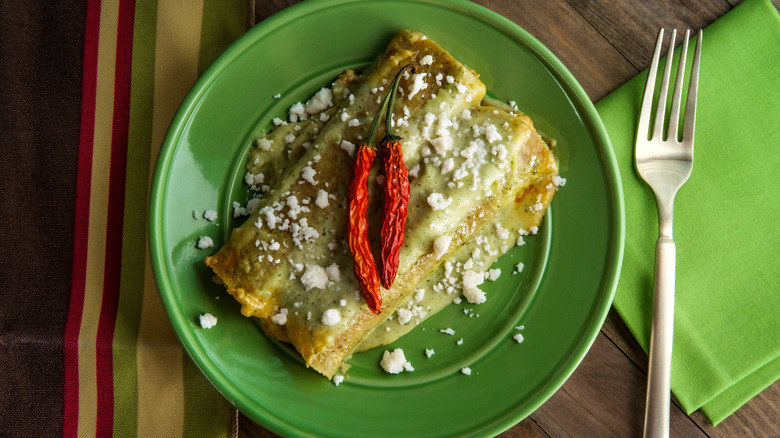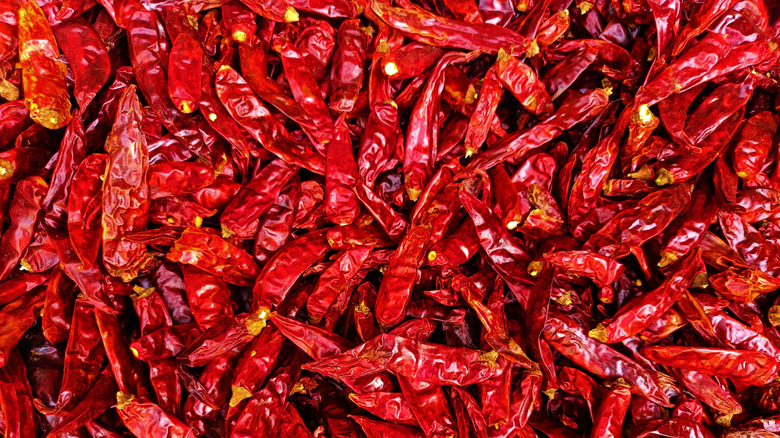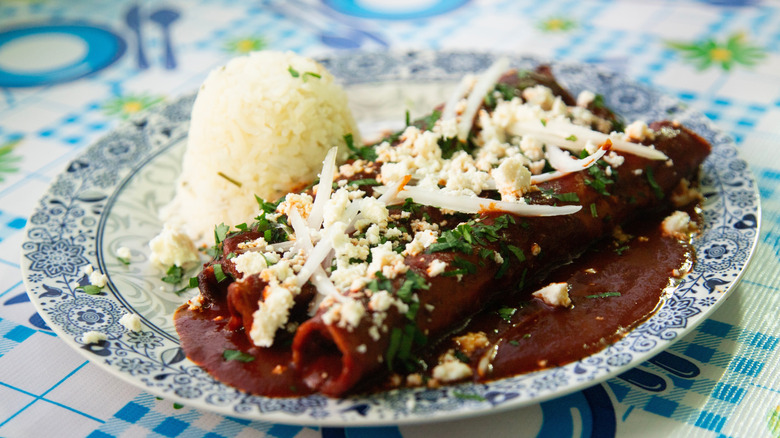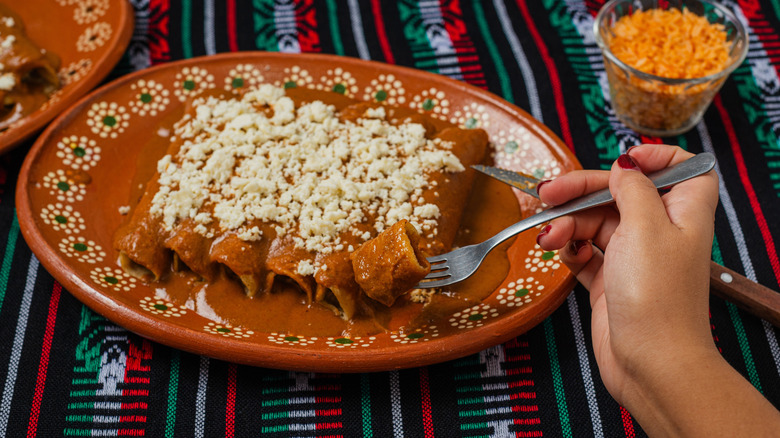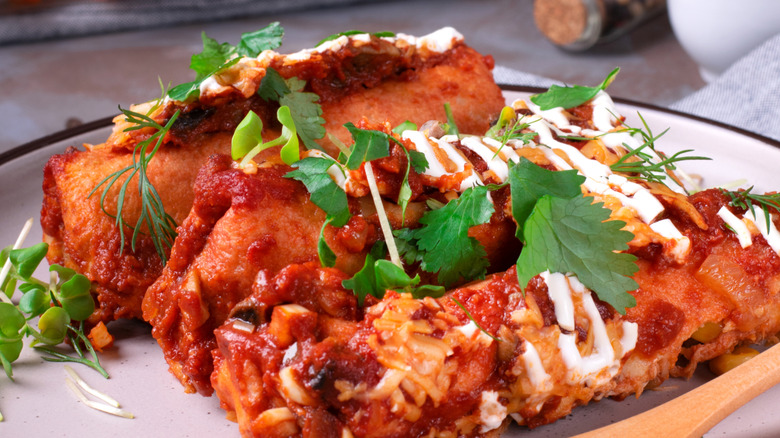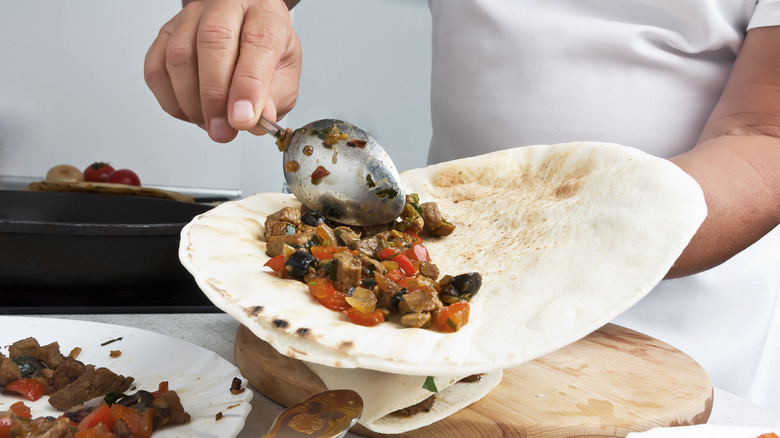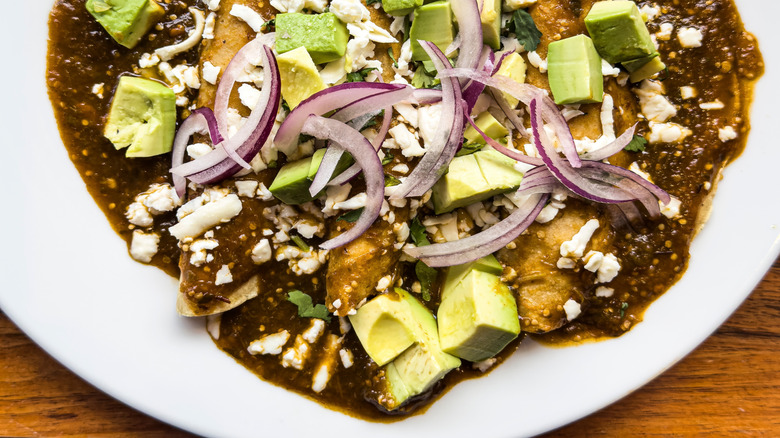Why Enchiladas Are Always Better At A Restaurant
While heading to a restaurant doesn't guarantee amazing enchiladas, there are some eateries where everything comes together perfectly. The tortillas are soft but not falling apart, the sauce is rich and complex, the fillings flavorful, and the cheese rounds things out with creaminess and a tang. This can leave you wondering why restaurant enchiladas are so superior.
Perhaps you have a favorite Mexican restaurant that does stellar enchiladas. You then try to recreate them at home and they're fine at best. Rather than layers of complex flavors, they taste basic. So what are you doing wrong?
We spoke to two chefs to dish the dirt on restaurant quality enchiladas. And, it seems that it's not just one thing that's different, it's pretty much everything. From the hours that chefs put in marinating, brining, simmering, and slow roasting to the perfect finishing touches.
There are oversights and mistakes you might be making with enchiladas that can mean the difference between restaurant quality and something that tastes like most of the ingredients come from a jar. Sure, not everyone wants to put hours of effort into cooking at home, but following chef tips will definitely up your game if you want to improve. Here's why enchiladas are always better at a restaurant.
They're made with more complex sauces
When you're making enchiladas at home, many people use ready made sauces. These might be fine for someone trying to make a quick dinner in a pinch, but they're not going to give you restaurant-quality results. Even if you end up making your own enchilada sauce, it might just be a simple one, where you simmer some canned tomatoes or passata with spices and call it a day. By contrast, chefs put a lot of effort into their sauces, deeming them a vital part of the dish.
"The sauce is just as important as the filling — if not more," says Gerardo Duarte, the executive chef of Mayahuel, a family-owned Mexican restaurant in Astoria, NY. He says that home cooks often buy pre-made enchilada sauce, but this usually contains preservatives and doesn't have as much depth of flavor as sauces made in-house, with their layered flavors and slow, careful preparation.
"In our kitchen, our sauces are complex, our mole sauce has 12 ingredients, we dehydrate and blend chiles ourselves," Duarte tells us. He says that all the components, even right down to the stock, are made from scratch. "That makes a big difference in taste," he adds.
There are no shortcuts in a quality enchilada sauce. Those made at Mayahuel start with a deep base: slow-roasted vegetables, homemade stock, and dried chiles. "It's time-consuming, but that's what gives it the restaurant quality," says Duarte.
Restaurants may use tortillas made in house
One of the biggest upgrades restaurant enchiladas have over homemade versions is the tortilla itself. At many good Mexican restaurants, the tortillas are made fresh daily and this makes all the difference. "The tortilla is just as important as the sauce and filling — it needs to hold up but still have that soft, pliable bite," says Chef Gerardo Duarte.
At Mayahuel, the tortillas are made from scratch with house-made nixtamal masa. However, if the chefs there didn't make their own, it doesn't mean any old ones would do. According to Duarte, "we'd still look for tortillas with minimal preservatives and a good texture."
This attention to tortillas makes a noticeable difference. A fresh, handmade tortilla doesn't just wrap around the filling. Rather, it binds with the sauce, holds its shape without tearing, and adds its own subtle flavor. "We make our own corn tortillas at Sor Ynez," says the restaurant's executive chef Alex Tellez. "Since they're made with masa, the sauce binds with them nicely."
Of course, not everyone has the time (or equipment) to make tortillas from scratch at home. Tellez admits he doesn't always either. "I don't make my own tortillas when I make this at home, and I like to look for a thicker tortilla to hold up to the sauce," he shares. If you're buying tortillas, look for ones made with as few additives as possible and go for a thicker style. It'll make your homemade enchiladas that much closer to restaurant quality.
Chefs know how to prep tortillas properly
Even if you buy better tortillas, there's another restaurant secret that takes enchiladas to the next level: how the tortillas are prepped. It's not enough to just grab a tortilla, fill it, and roll it up. Chefs take an extra step that makes a huge difference in the final dish.
"Coating the tortillas in hot oil is key," says Chef Gerardo Duarte of Mayahuel. "It's a small step that makes a big difference. It not only prevents them from falling apart but also helps the tortillas soak up the sauce in the right way."
This quick fry — usually just a few seconds per side in hot oil — softens the tortillas and makes them more pliable, which helps prevent cracking when you roll them. It also creates a light barrier that keeps the tortillas from becoming soggy too quickly once they're covered in sauce. Instead of disintegrating into mush, they stay tender with just the right amount of chew.
At home, it's an easy trick to steal. Heat a thin layer of oil in a skillet and quickly dip each tortilla before assembling your enchiladas. It's a tiny bit of extra effort, but it'll make your enchiladas more like the ones you love from your favorite restaurant.
Restaurant-quality enchiladas are made with a wider variety of fillings
Another big reason restaurant enchiladas often taste better than homemade ones comes down to the fillings. At home, it's easy to default to basic choices like shredded chicken or ground beef. But restaurants tend to go a lot further with flavor and creativity.
"The biggest difference between a restaurant-style enchilada and homemade ones is usually the filling," says Chef Alex Tellez. He explains that the variety of flavors and fillings is what sets restaurant enchiladas apart from homemade ones. And, you don't even need meat to make a hearty enchilada filling. "At Sor Ynez, we serve our enchiladas with potato filling, bathe them in guajillo sauce, and garnish them with pickled vegetables," Tellez explains.
It's not just about swapping chicken for potatoes, either. Restaurants often feature proteins and techniques that are a bit outside the home cook's usual comfort zone. "In a restaurant setting, we have the time and tools to properly prepare more complex proteins — we use fillings like duck or rabbit — that many home cooks might not be familiar with or know how to handle," says Chef Gerardo Duarte. These ingredients usually need special preparation, like slow braising or precise seasoning, and they're carefully matched with sauces to bring out their best flavors.
Even if you're sticking with more familiar proteins at home, thinking beyond the basics — like using roasted vegetables, marinated tofu, or well-seasoned beans — can make your homemade enchiladas feel a lot more restaurant-worthy.
Chefs pay attention to ingredient quality
If you want to make better enchiladas, you need to shop like a chef. Most people just go to the grocery store and buy whatever's available — ready made spice mix, under ripe tomatoes, or rock hard avocados. But when homemade enchiladas just aren't hitting like the ones you get at your favorite restaurant, the problem might be hiding in your grocery cart. It's tempting to grab whatever tortillas, canned sauce, and cheese you find at the store — but chefs take a much more deliberate approach.
Ingredient quality is everything, Chef Gerardo Duarte of Mayahuel tells us. "From the chiles to the cheese, and even the oil we use — if the ingredients aren't top quality, it shows." In restaurant kitchens, nothing is left to chance. Stocks are made from scratch, spices are blended in-house, and every product is chosen carefully. "The process means nothing if the base ingredients aren't great," Duarte explains.
At home, small upgrades go a long way. Try using fresh tortillas (or better quality ones with minimal preservatives), real Mexican cheeses like queso fresco or Oaxaca, and dried chiles instead of pre-mixed powders when you can. Ultimately, the better your starting ingredients, the better your enchiladas will be. A little extra effort sourcing ingredients pays off on the plate.
Restaurant enchiladas have a thicker sauce consistency
One thing that often separates restaurant enchiladas from homemade ones is the sauce — not just the flavor, but the texture. Many home cooks make sauces that are too thin, and it shows. The sauce slides right off the tortillas instead of clinging to them, leaving the dish watery and underwhelming.
"The most important part of any enchilada is that the sauce binds to the tortilla," says Alex Tellez. "You'll want to make the sauce a thicker consistency so it sticks to the top of the tortilla and doesn't fall off when you sauce it."
At restaurants, sauces are often simmered longer or thickened carefully to get the perfect texture. They're rich and clingy, coating each enchilada in layers of flavor rather than pooling at the bottom of the plate. And the thick sauce also makes a difference to tortilla choice, so the two go hand-in-hand. "You'll want to choose a tortilla that can stand up to a thicker sauce, so look for one that's thicker or made with masa," Tellez advises.
If you're making enchiladas at home, it's worth taking the extra time to simmer your sauce a little longer until it reduces and thickens. You can also blend in roasted vegetables or a small amount of masa harina to help it hold. A thicker sauce gives you better results all-round.
Enchiladas from restaurants are often spicier
Another difference you might notice when you order enchiladas at a restaurant is the heat. Many home cooks tend to play it safe with spice, but restaurant enchiladas often bring more of a kick. This makes more of a difference to the finished dish than you might imagine.
"The heat level for the sauce is higher at restaurants for spicier enchiladas," says Chef Alex Tellez. Part of that comes from confidence. Chefs know how to balance spice with other flavors, building a sauce that's fiery but still layered and complex. Plus, diners are often more willing to try bolder flavors when they're eating out. Sometimes they even discover they like more heat than they thought.
At home, it's common to hesitate. No one wants to ruin dinner with a sauce that's overwhelmingly spicy, so many home cooks lean toward milder versions. But you don't have to skip spice altogether. Even a little bit of extra heat can level things up and make your homemade version closer to your restaurant faves.
Of course, everyone's spice tolerance is different, and not every enchilada needs to be extra hot. But a touch of heat from dried chiles, fresh jalapeños, or a splash of spicy sauce can bring your homemade version to life. You can always adjust it to your taste.
Chefs are intentional with their cheese choices
Cheese might seem like an easy part of making enchiladas — just sprinkle on whatever's in the fridge, right? But at restaurants, chefs are much more deliberate with their choices, and it shows in the final dish.
Chef Gerardo Duarte of Mayahuel uses a mix of cheese. "Inside the enchilada, we go for melty cheeses like Chihuahua," he says. "On top, we often use queso fresco for that tangy, fresh contrast." Instead of just grabbing a pre-shredded bag of cheddar or Monterey Jack, restaurant chefs think carefully about how the cheese will melt, how it will taste with the sauce, and even the texture it will add.
The type of sauce can also influence the cheese choice. "The cheese I prefer to use depends on the sauce," says Chef Alex Tellez of Sor Ynez. "I opt for queso fresco when I use a mild sauce." A bolder, spicier sauce might call for a different pairing to keep the flavors balanced.
At home, it's easy to upgrade your enchiladas by paying a little more attention to the cheese you use. Look for Mexican cheeses like queso fresco, cotija, or Oaxaca if you can find them. If not, a good-quality Monterey Jack or a Gruyere can work for melting inside, with a sprinkle of feta or goat cheese for a bit of that salty, tangy finish on top. A thoughtful cheese choice can pull all the flavors together and make your enchiladas taste much closer to restaurant quality.
Restaurant enchiladas have complex, layered flavors
When you dig into a plate of restaurant enchiladas, you might not be able to pinpoint every ingredient, but you can tell there's something deeper and more complex going on. Compared to homemade versions, restaurant enchiladas often have richer, more layered flavors.
"It's the layers of preparation — from the way the meat is cooked to the sauces and tortillas," explains Gerardo Duarte. Chefs pay the kind of attention to detail that's hard to match at home. Not to mention how much time they invest in getting things right — it is their job after all. "Diners may not realize every ingredient and technique used are made with intention, but they taste it in the final dish," Duarte remarks.
At a restaurant, the fillings aren't just tossed together; the meat might be slow-braised for hours, seasoned with house-made spice blends, or paired with fresh herbs. The sauces aren't one-note. They're developed with roasted chiles, rich stocks, and deeply caramelized vegetables. Even the tortillas and garnishes add to the magic.
At home, it's easy to rush through steps to get dinner on the table. But if you want to create enchiladas with restaurant-level flavor, slowing down and adding a few extra layers — like marinating your protein, simmering a homemade sauce, or using fresh garnishes — can make a huge difference. Every little detail builds on the next, creating that depth of flavor rarely found outside of a professional kitchen.
The finishing touches make all the difference
Enchiladas aren't just about the sauce or the filling — the finishing touches elevate the dish and make it restaurant-worthy. While home cooks might serve their enchiladas straight from the pan, chefs know that a few final elements can transform the entire plate.
"Finishing with a fresh drizzle of crema, chopped herbs like cilantro, and a sprinkle of onion or radish adds texture, brightness, and color," says Gerardo Duarte of Mayahuel. "It brings everything together and wakes up the whole dish." Alex Tellez also talks about how Sor Ynez's classic enchiladas are finished with pickled vegetables, backing up the importance of the right finishing move.
These simple but intentional garnishes do more than just make the enchiladas look pretty. They introduce fresh flavors that balance the richness of the sauce and fillings. Creamy, tangy crema, for instance, contrasts perfectly with the heat and depth of the sauce. Fresh cilantro introduces an herby note that cuts through the heaviness, brightening each bite.
At home, it's easy to forget these final flourishes, but they can take your enchiladas to the next level. A little crema, some fresh herbs, and a few crunchy garnishes can balance and complete the dish — just like at your favorite restaurant.
Chefs put more time and technique into creating perfect enchiladas
Here's where restaurant enchiladas have the advantage over homemade ones is the amount of time and technique chefs invest into every step of the process. While home cooks often take shortcuts to get a meal on the table quickly, chefs have the luxury of time and the expertise to create a dish with multiple layers of flavor.
"In a restaurant, you can take the time to properly prepare proteins," says Gerardo Duarte. "For example, our chicken is brined overnight, then marinated with a salt blend we make in-house using dried chiles before being slow-roasted." This meticulous preparation results in chicken that's incredibly flavorful and tender — a stark contrast to the more rushed approach that most home cooks might take, like simply shredding a rotisserie chicken.
The same attention to detail applies to the sauces, fillings, and tortillas. Chefs have the time to carefully simmer sauces for hours, develop complex spice blends, and ensure that each tortilla is fried or toasted to the perfect texture. At home, it's easy to skip these steps, especially when you're short on time or just looking for convenience.
By dedicating more time to each element of the dish, chefs create enchiladas that have depth, richness, and balance — something that's tough to replicate when you're trying to get dinner ready in a rush. But with a little extra time and attention to detail, you can elevate your own homemade enchiladas and bring some restaurant-quality techniques into your kitchen.
Some restaurants may have particular regional influences
You might notice the variety of the fillings available in restaurant enchiladas, which often reflect the chef's regional influences. As Chef Alex Tellez of Sor Ynez points out, "There are different varieties of enchiladas depending on the state of Mexico the chef is from."
In Mexico, each region has its own twist on enchiladas, with unique fillings, sauces, and cooking techniques. For example, in the state of Oaxaca, enchiladas are often filled with rich, smoky mole. The complex, earthy sauce adds a layer of depth that you rarely find in a typical homemade enchilada. Then, the Yucatán region is known for its use of achiote paste, which is made from natto seeds, alongside herbs and spices like cumin, oregano, and coriander. And these are just a couple of the many regional variations.
At home, it's easy to default to one type of filling and sauce, but looking to regional influences can give you much-needed inspiration. Bringing a regional flair to your enchiladas can make them feel like they're straight from a restaurant that knows what it's doing.
